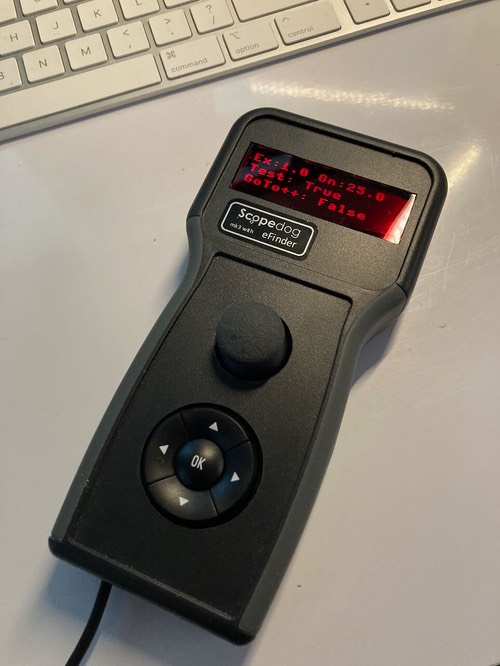Another Covid lockdown project was the development of a digital finder for my 18”. I call it an ‘eFinder’.

It is fully described here.
Here’s a photo of the latest version installed on my 18” Dobsonian.
Basically it is a very fast imager with a small field of view. Images are plate solved to determine the precise pointing of the eFinder.
The eFinder can be mechanically aligned to the main telescope optical axis, or there is a calibration routine that measures the alignment error and subsequently applies it to displayed results.
Thus the eFinder is effectively determining where the main scope is pointing, to better than 1 arc minute.
I can use this in various ways.
- Refine Goto’s. The ScopeDog drive typically gets me within 10 arc mins of the target. The errors are down to initial Nexus DSC alignment and the stability and orthogonality of my scope mount.
The eFinder can automatically finish the goto by sending the scope drive commands to close out any error. - Make initial two star alignments easier. Instead of aligning on Named Stars in the Nexus catalogue, I can just point my scope at a convenient part of the sky and the eFinder will determine the position very accurately and send the result to the Nexus DSC as a pseudo alignment ‘star’.
- 'Local Sync’ is easy. The eFinder quickly resolves true RA & Dec of where it is pointing and sends that to the Nexus DSC as a local sync point. Also makes building an MPoint model very easy.
- A new hand box has been made, combining ScopeDog & eFinder functions into one. The OLED text display can now be used for ScopeDog functions as well.

The eFinder communicates with the mk1 or mk2 ScopeDog via the Nexus DSC USB port.
eFinder works with mk1 & mk2 ScopeDog but requires a separate eFinder processor box. For mk2 users, the ScopeDog firmware can be updated to include the eFinder within the existing ScopeDog control box.
This results in a 'ScopeDog mk3eF' and no need for a separate eFinder processor box. The camera just plugs directly into the main ScopeDog drive box.
The eFinder firmware has now been updated to work with ServoCat systems.

Latest update is the ability to see an analysis of the eFinder image. It shows the peak star image value, the number of stars found and a thumbnail image and Point Spread Function of the brightest star.This facilitates focusing and exposure tweaking.